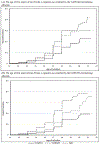Internalizing and externalizing problems on the age of e-cigarette initiation in youth: Findings from the Population Assessment of Tobacco and Health (PATH), 2013-2017
- PMID: 35716810
- PMCID: PMC10234265
- DOI: 10.1016/j.ypmed.2022.107111
Internalizing and externalizing problems on the age of e-cigarette initiation in youth: Findings from the Population Assessment of Tobacco and Health (PATH), 2013-2017
Abstract
Previous research has established an association between internalizing and externalizing problems with e-cigarette use in youth. Secondary analysis of Population Assessment of Tobacco and Health youth waves 1-4(2013-2017). Age of initiation of ever e-cigarette use and age of first report of past 30-day e-cigarette use were prospectively estimated among never e-cigarette users(waves 1-3). Weighted interval-censoring multivariable Cox proportional hazard models were fit to assess differences in each e-cigarette outcome among youth with internalizing and externalizing problems, as well as the interaction between internalizing and externalizing problems, while adjusting for covariates. Weighted interval-censoring survival analyses estimated the age of initiation of ever and age of first report of past 30-day e-cigarette use stratified by internalizing and externalizing problems. Among youth never e-cigarette users, those with high internalizing problems and high externalizing problems had increased risk of initiating ever e-cigarette use at earlier ages compared to youth with none/low internalizing and externalizing problems, respectively. Youth with high internalizing problems and high externalizing problems had increased risk of first reporting past 30-day e-cigarette use at earlier ages compared to youth with none/low internalizing problems, respectively. By age 17, 36.3% of youth with high internalizing problems and 38.5% of youth with high externalizing problems initiated ever e-cigarette use. By age 17, 16.8% of youth with high internalizing and 18.7% of youth with high externalizing problems first reported past 30-day e-cigarette use. Youth with internalizing and externalizing problems should be screened for e-cigarette use and provided with proper resources to prevent onset of e-cigarette use.
Keywords: Adolescents; Health disparities; Mental health; Public health education; Risk factors; Tobacco.
Copyright © 2022 Elsevier Inc. All rights reserved.
Conflict of interest statement
Figures
Similar articles
-
Age of e-cigarette initiation in USA young adults: Findings from the Population Assessment of Tobacco and Health (PATH) study (2013-2017).PLoS One. 2021 Dec 13;16(12):e0261243. doi: 10.1371/journal.pone.0261243. eCollection 2021. PLoS One. 2021. PMID: 34898629 Free PMC article.
-
The mediating roles of mental health problems and racial differences in the linkage between social media use and E-cigarette use among American youth.Prev Med. 2024 Feb;179:107842. doi: 10.1016/j.ypmed.2023.107842. Epub 2023 Dec 31. Prev Med. 2024. PMID: 38169240
-
Role of Mental Health in the Association Between E-Cigarettes and Cannabis Use.Am J Prev Med. 2022 Mar;62(3):307-316. doi: 10.1016/j.amepre.2021.09.012. Epub 2021 Dec 20. Am J Prev Med. 2022. PMID: 34949509 Free PMC article.
-
Association of cigarette and electronic nicotine delivery systems use with internalizing and externalizing problems among US adults: Findings from wave 3 (2015-2016) of the PATH study.PLoS One. 2021 Jun 15;16(6):e0253061. doi: 10.1371/journal.pone.0253061. eCollection 2021. PLoS One. 2021. PMID: 34129631 Free PMC article.
-
Trajectories of polysubstance use: Are past-year internalizing and externalizing problems associated with trajectories of polysubstance use over time?Addict Behav. 2024 Dec;159:108136. doi: 10.1016/j.addbeh.2024.108136. Epub 2024 Aug 18. Addict Behav. 2024. PMID: 39173424 Review.
Cited by
-
Does the time to nicotine dependence vary by internalizing symptoms for young people who use e-cigarettes? An analysis of the Population Assessment of Tobacco and Health (PATH) study, (Waves 1-5; 2013-2019).Addict Behav. 2024 Sep;156:108075. doi: 10.1016/j.addbeh.2024.108075. Epub 2024 May 25. Addict Behav. 2024. PMID: 38810488
-
Anxiety as a predictor of the age of initiation of tobacco and cannabis use in adolescents and young adults.Addict Behav. 2024 Jan;148:107876. doi: 10.1016/j.addbeh.2023.107876. Epub 2023 Oct 2. Addict Behav. 2024. PMID: 37804749 Free PMC article.
-
E-cigarette usage and mental health among undergraduate medical and health sciences students.Sci Rep. 2025 Apr 16;15(1):13169. doi: 10.1038/s41598-025-94545-6. Sci Rep. 2025. PMID: 40240761 Free PMC article.
References
-
- Balfour DJ, & Ridley DL (2000). The effects of nicotine on neural pathways implicated in depression: a factor in nicotine addiction? Pharmacology Biochemistry and Behavior, 66(1), 79–85. - PubMed
-
- Conway KP, Green VR, Kasza KA, Silveira ML, Borek N, Kimmel HL, … Compton WM (2018). Co-occurrence of tobacco product use, substance use, and mental health problems among youth: Findings from wave 1 (2013–2014) of the population assessment of tobacco and health (PATH) study. Addictive Behaviors, 76, 208–217. doi:10.1016/j.addbeh.2017.08.009 - DOI - PMC - PubMed
-
- Dennis ML FT, Stevens LH, Bedoya L (2008). Global Appraisal of Individual Needs- Short Screener (GAIN-SS): Administration and Scoring Manual Version 2.0.3. In. Bloomington, IL: Chestnut Health Systems.
Publication types
MeSH terms
Grants and funding
LinkOut - more resources
Full Text Sources
Medical
Miscellaneous



